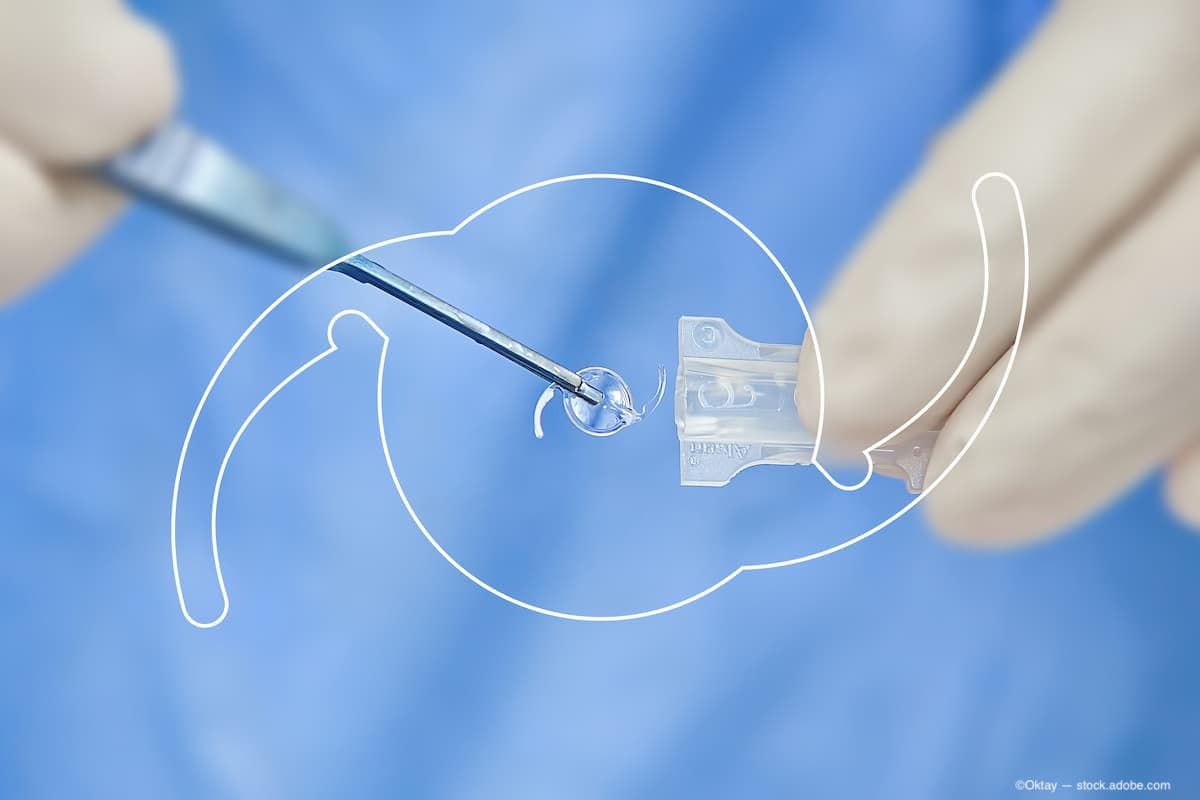Article
Capsule opacification with 2 different IOLs: 3-year results
Author(s):
This follow-up study found anterior capsule opacification development and anterior capsule retraction to be more frequent 3 years after cataract surgery when an IOL with interrupted sharp optic edge at the optic–haptic junction is implanted, compared with an IOL with a continuous edge.
Take-home message: This follow-up study found anterior capsule opacification development and anterior capsule retraction to be more frequent 3 years after cataract surgery when an IOL with interrupted sharp optic edge at the optic–haptic junction is implanted, compared with an IOL with a continuous edge.
By Faye Emery; Reviewed by Dr Guenal Kahraman
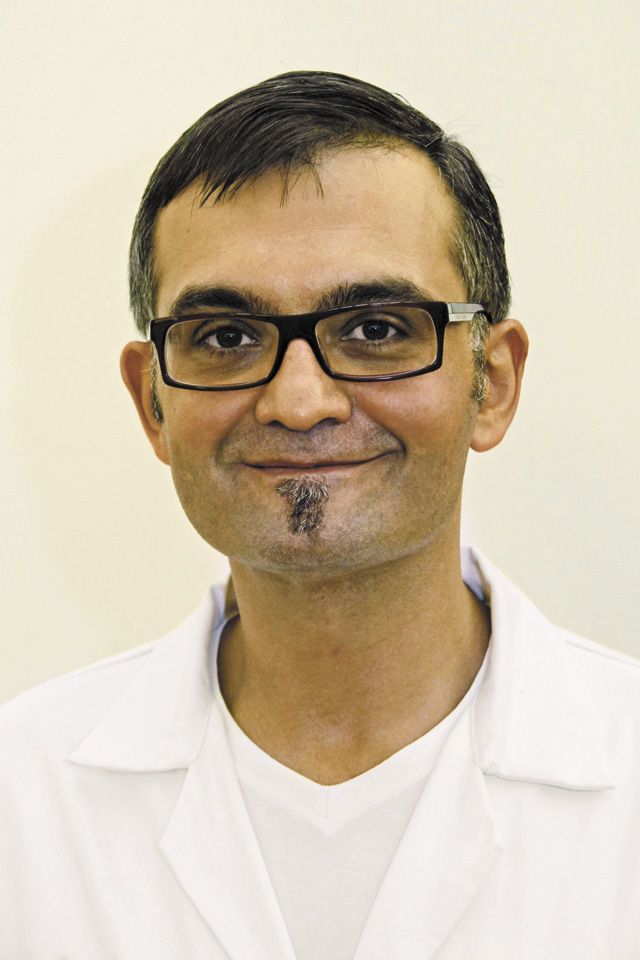
Dr. Guenal KahramanThe material and design of intraocular lens’ (IOL), especially at the optic edge, are both relevant factors when it comes to anterior (ACO) and posterior capsule opacification (PCO) development.1–4 Sharp optic edges have previously been shown to prevent migration of epithelial cells between the capsular bag and the IOL.1–3 In this study, the authors evaluated and compared the degree of PCO, ACO and anterior capsule retraction, 3-years after implantation of 2 different single-piece hydrophobic acrylic IOLs. One of the implanted lenses featured a 360-degree continuous sharp optic edge (Tecnis ZB00, Abbott Medical Optics, Inc., Illinois, USA) whereas the other had an interrupted square edge (Acrysof SA60AT, Alcon Surgical, Inc., Surrey, UK).
Patient follow-up
Between October 2009 and September 2013, 80 patients who had previously undergone uneventful phacoemulsification with bilateral senile cataract that induced a significant visual deterioration were enrolled in the study at the Hospital of St. John of God (Vienna, Austria).5 Each patient randomly received 1 IOL model in 1 eye and the other model in the fellow eye by the same surgeon.
During follow-up visits, a complete ophthalmologic examination including slitlamp biomicroscopy, applanation tonometry, and fundus examination were performed. The ACO grading was carried out subjectively with a slitlamp by 1 experienced examiner. The Evaluation of Posterior Capsule Opacification (EPCO) software developed by Tetz et al.6 was used to quantify PCO.
In case you missed it: Navigated panretinal photocoagulation vs conventional pattern laser for PDR
During the final follow-up visit, 3-years post-implantation, the investigators were able to analyse images of 50 patients (100 eyes) out of the original 80 (Figures 1-3). Patient age ranged from 61 to 80 years with a mean value of 70.2 years ± 9.3 (SD).
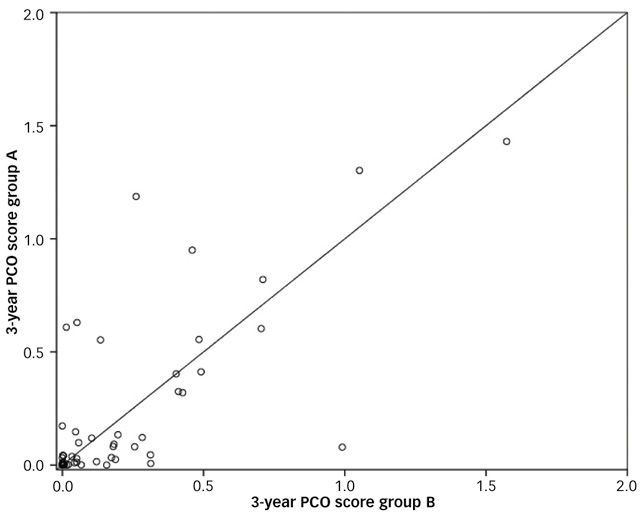
(Figure 1) Scattergram showing the relationship between the PCO level 3 years postoperatively in eyes implanted with the Acrysof IOL (group A), and eyes implanted with the Tennis IOl (group B). Each circle corresponds to one patient.
Differing outcomes between PCO and ACO
No significant differences in PCO score were found between Acrysof IOL and Tecnis IOL. (3 year follow-up visit: Acrysof 0.23 ± 0.36 versus Tecnis 0.22 ± 0.32, P = 0.66). Anterior capsule opacification was present in Acrysof 18.0% and Tecnis 2.7% (P = 0.03) and in 92.0% and 24.0% of eyes (P < 0.01) at 1 and 3 years after surgery, respectively.
The authors noted that low mean PCO scores were obtained with both types of IOL, with no significant differences between them throughout the follow-up period. It was suggested that IOL material was a crucial factor for the observed low levels of PCO. However, when it came to analysing the ACO results, outcomes were very different to those found for PCO. Significantly higher percentages of ACO and overall higher scores were observed in eyes implanted with the interrupted square optic edge IOL compared to those implanted with the continuous square optic edge IOL. As each type of IOL was implanted in fellow eyes of the same patient (thus the study was an intraindividual comparison), the authors suggested differences in IOL surface properties and design as an explanation for this finding.
Next: Continued + Figures

(Figure 2) Frontal biomicroscopic image showing one case of moderate ACO (Grade 3) in an eye implanted with the Acrysof IOL.
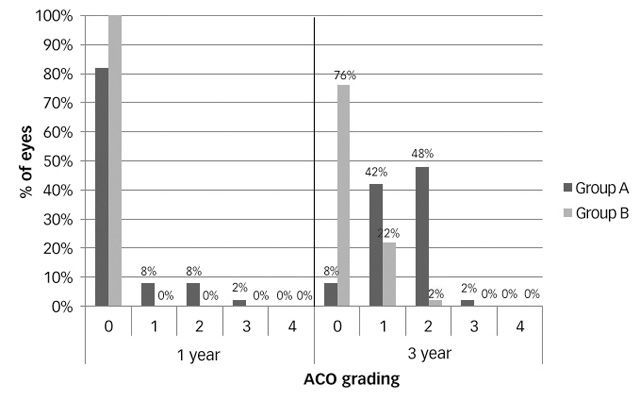
(Figure 3) Distribution of the level of ACO in the two evaluated groups
Next: Continued
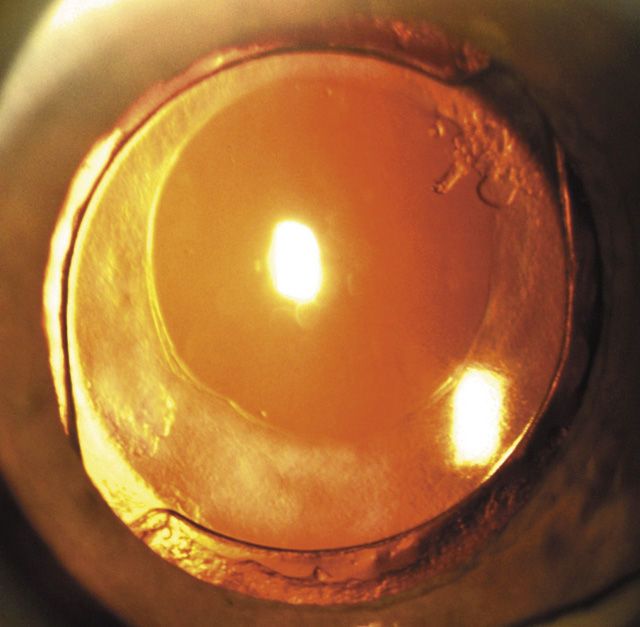

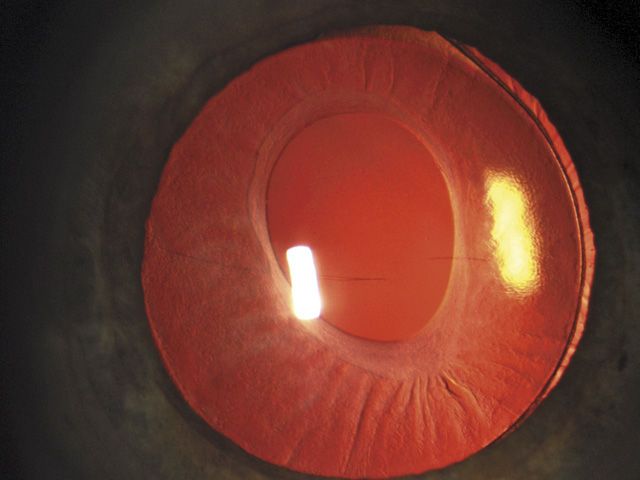
Next: Lens design and surface properties
Lens design and surface properties
The Acrysof SA60AT is a biconvex IOL with a 0-degree haptic angulation whereas the Tecnis ZCB00 is a biconvex IOL with an offset haptic design, providing 3 points of fixation. The interruption of the square optic edge at the optic–haptic junction as well as the configuration of the IOL optic surface may promote or facilitate the migration of lens epithelial cells (LECs) to the space between the anterior capsule and the IOL (Figure 4). The sharp posterior edge inhibits migration of anterior capsule LECs behind the optic, therefore resulting in slightly stronger ACO. The gunnel, a kind of circular groove in the periphery of the Tecnis ZCB00 IOL might further prevent LECs to migrate on the anterior surface of the IOL. A better understanding into this association could possibly be gleaned following further studies into the potential impact of this design on the developmental process of ACO.
The authors also proposed that the opacification of the anterior and posterior capsule seem to be simultaneous processes in eyes that are implanted with a square optic edge IOL. This proposal was fuelled by the significant increase observed in the level of ACO throughout the follow-up, as was also found for the level of PCO.
“Our study is one of the first papers which shows that the design is more important than material. As both study IOLs are made of almost same material, I believe the design of the IOL is crucial.” Dr Kahraman explained.
Study conclusions
In response to the study results, the authors concluded that there was no statistically significant difference in PCO rate between the 2 IOL models after 3 years. However, the ACO development and anterior capsule retraction was significantly higher at the Acrysof group.
Dr Kahraman added that “a certain amount of ACO is desirable. We know that ACO might reduce the dysphotopsia and PCO, but severe ACO would cause IOL decentration and affect visual quality.”
Next: This design is key
As IOLs were implanted in fellow eyes of the same patient and the two IOLs evaluated in the study were made of hydrophobic acrylic material, the factors inherent in the individual patient can be disregarded. Specifically, differences in IOL surfaces properties and design could explain the difference between IOLs in the ACO rate. Different anterior capsule behaviour is present postoperatively in eyes implanted with IOLs with a 360º continuous sharp optic edge compared to those without. The retraction of the anterior capsule might increase the shrink-wrap effect of the capsular bag and which might reduce the PCO formation. It is debatable whether it is indeed desirable to reduce the risk for PCO at the expense of a higher rate of ACO and capsule retraction.
To summarise the article findings, the authors believe that the design of the IOL is the key reason behind the observed rates of ACO in this particular study.
References
T. Kohnen et al., Ophthalmology. 2008; 115:1308–1314.e1–3
O. Findl et al., Ophthalmology. 2005;112: 67–72.
W. Buehl, et al., J. Cataract. Refract. Surg. 2005;31:954–961.
S.R. Smith et al., Am. J. Ophthalmol. 2004; 138:521–526.
G. Kahraman et al., J. Cataract. Refract. Surg. 2015; pii: S0886-3350(15)00426-5. doi: 10.1016/j.jcrs.2014.07.041. [Epub ahead of print]
M.R. Tetz et al.,J. Cataract. Refract. Surg. 1997;23:1515–1520.
Dr Guenal Kahraman
e: kahraman@gmx.at
Dr Guenal Kahraman is consultant ophthalmic surgeon at the Academic Teaching Hospital of St John, Krankenhaus der Barmherzige Brüder, Vienna, Austria.
The author has no financial disclosures relating to the content of this article.
Newsletter
Don’t miss out—get Ophthalmology Times updates on the latest clinical advancements and expert interviews, straight to your inbox.





